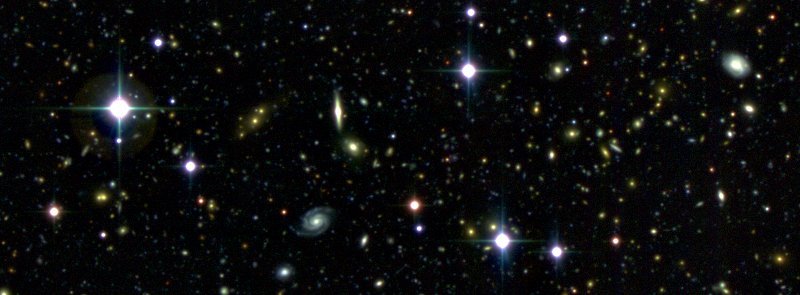I have moved. Please see my up-to-date web page here. The download links on this page remain valid.
Public data
This section provides some data from past publications for download. You are welcome to use it for your own work. More information is provided in the indicated source(s). Please e-mail me in case of any questions.
MACS J0416.1-2403
MPG/ESO-2.2m WFI imaging data of Hubble Frontier Field cluster MACS J0416.1-2403 in B/#842 (stack, weight), V/#843 (stack, weight), R/#844 (stack, weight) and I/#879 (stack, weight) filters. The extinction corrected Vega R band zeropoint based on standard star photometry is 24.73.
A multi-band photometry catalog, detected on the R band image and measured on seeing-matched frames, is available here. You have to apply (add) a zeropoint offset of -0.26 (B), -0.12 (V), 0.10 (R) and -0.17 (I) to the aperture magnitudes.
Public code
This section makes available some code that I have contributed to for past projects and that might be useful for other purposes, too. If you use a code in your work, I greatly appreciate your feedback, patches/improvements and referencing of related publications. In case of any questions, don't hesitate to contact me.
Cosmic variance of cluster density profiles
This is an implementation of the model described here. It predicts the variation of the projected density / convergence profile of cluster haloes of fixed mass, based on three semi-analytic components: variation of halo concentration, ellipticity, and the presence or absence of correlated secondary haloes. The code can return the covariance matrix in convergence for any set of angular bins and at arbitrary redshift. Note that the model was fitted at z=0.25 and tested also at z=0.5 with a radial range of 1 to 30 arcmin and for 200m masses of 10^14 to 10^15 h^-1 solar -- outside that, you're extrapolating. This tarball contains all code and will download additional pre-computed template files as needed.
Relevant publications: paper describing the model
Clipped mean in SWarp
The code has been included in version 2.38 of SWarp and can be downloaded from the official Astromatic website. There are two small tools useful in combination with the clipped mean mode: MaskMap, which uses the list of outlier pixels this modified SWarp produces to generate single frame mask images, and PSFHomTest, which tests the homogeneity of your single frame PSFs to determine suitable clipping parameters such that the stack PSF is a linear combination of the single frame PSFs, both for download.
Relevant publications: paper describing the algorithm, first use in weak lensing science analysis, application to DES science verification data for cluster weak lensing.
psfex utilities
My library for access to PSFEx models can be downloaded here.
Relevant publications: first use in science analysis, metrics of modelling accuracy, Emmanuel Bertin's paper on PSFEx. Last update: 2014-01-16
FDNT
Reiko Nakajima has set up a public repository here, which contains Gary Bernstein's implementation of his Fourier Domain Null Testing shape measurement method along with, among other things, a ready-to-run wrapper using PSFEx PSF models contributed by myself.
Relevant publications: derivation of the method.
GalSim
GalSim is a galaxy image simulation toolkit in Python/C++ available here. I find it a very useful framework and have contributed to a module that simulates charge deflection, the so-called 'brighter/fatter' effect.
Relevant publications: description of GalSim, one of the underlying shear-relevant methods, description of the brighter/fatter effect, brighter/fatter in DECam and its effect on shape measurement.
